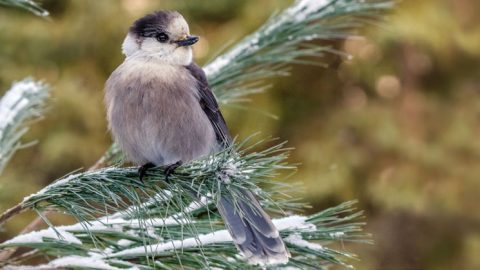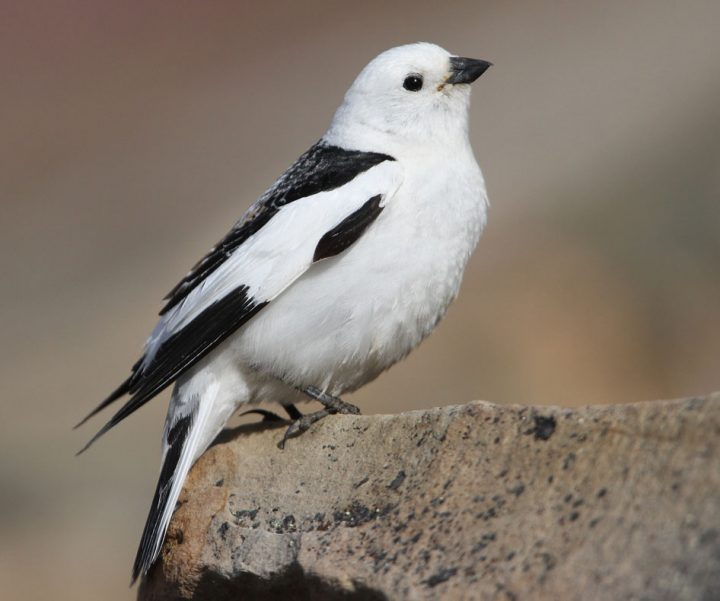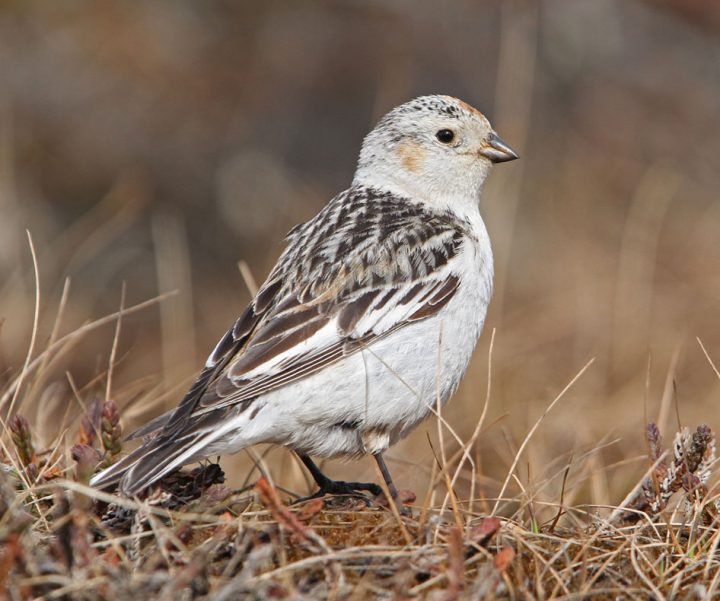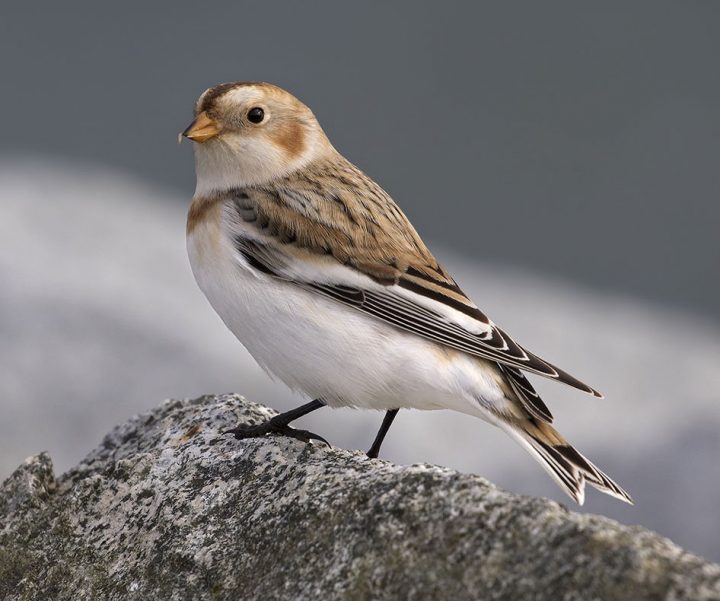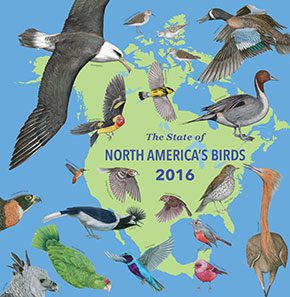Are Snow Buntings North America’s Hardiest Songbird?
By Nate Swick Snow Bunting flock by Melissa Groo.
January 8, 2018From the Winter 2018 issue of Living Bird magazine. Subscribe now.
There’s little about a Snow Bunting that isn’t perfectly suited to life in the deep freeze. These winter wanderers are outfitted like little polar explorers, with a natural down parka of dense white feathers that cover even the birds’ ankles and base of the bill—and keeps their exposure to cold at a minimum.
The adaptations are more than skin deep. A Snow Bunting’s body temperature can dip 30 to 40 percent lower than other songbirds their size before hypothermia sets in. As weather conditions deteriorate, Snow Buntings can adjust their metabolism to quickly turn food into insulating body fat. And when the cold air arrives, they bury themselves in snowdrifts for warmth.
All these feats add up to a species that breeds farther north than any other songbird, returning to its Arctic nesting territories in March and singing its heart out when temperatures can still drop well below zero. Snow Buntings are so hardy, in fact, that the only time most people get to see them is during winter, when flocks magically appear and disappear over snow-blown northern fields, seemingly undeterred by what we call winter.
For bird watchers, the little bird with a toasted marshmallow pattern is a bright spot in a gray winter. In eastern Canada, Snow Buntings have even inspired a citizen-science project. Started in 2006, the Canadian Snow Bunting Network has been collecting data on their occurrence during winter across almost all of the Canadian provinces. Now scientist Oliver Love is using the network’s extensive data set, along with his own findings from tracking individual birds, to open up a window on where these mysterious birds live their lives, and where they go when the weather gets bad.
In 2007 Love, of the University of Windsor, Ontario, and research associate Rick Ludkin came across a report of Christmas Bird Count data that suggested Snow Bunting populations had declined an alarming 64 percent in the last 40 years. The decline was attributed largely to a warming climate. “I was convinced it couldn’t be as simple as climate change,” explains Love, “and I was curious as to how the 64 percent was derived.” He decided to investigate.
Sadly, it’s not uncommon for songbirds to suffer such severe declines. Nearly four dozen other species have declined by more than 50 percent since 1970, according to the bird conservation group Partners in Flight. But Love knew that Snow Buntings were a special case. For one thing, they move around a lot, and it’s hard to measure populations of a species that show up in great numbers one year and are nearly absent the next. Furthermore, if climate is altering where Snow Buntings spend the winter, warming temperatures are liable to push them north, away from places where birders are most likely to find them. In both scenarios, the birds might not be declining, they just might not be getting counted.
To take a second look at the situation, Love turned to the Canadian Snow Bunting Network.
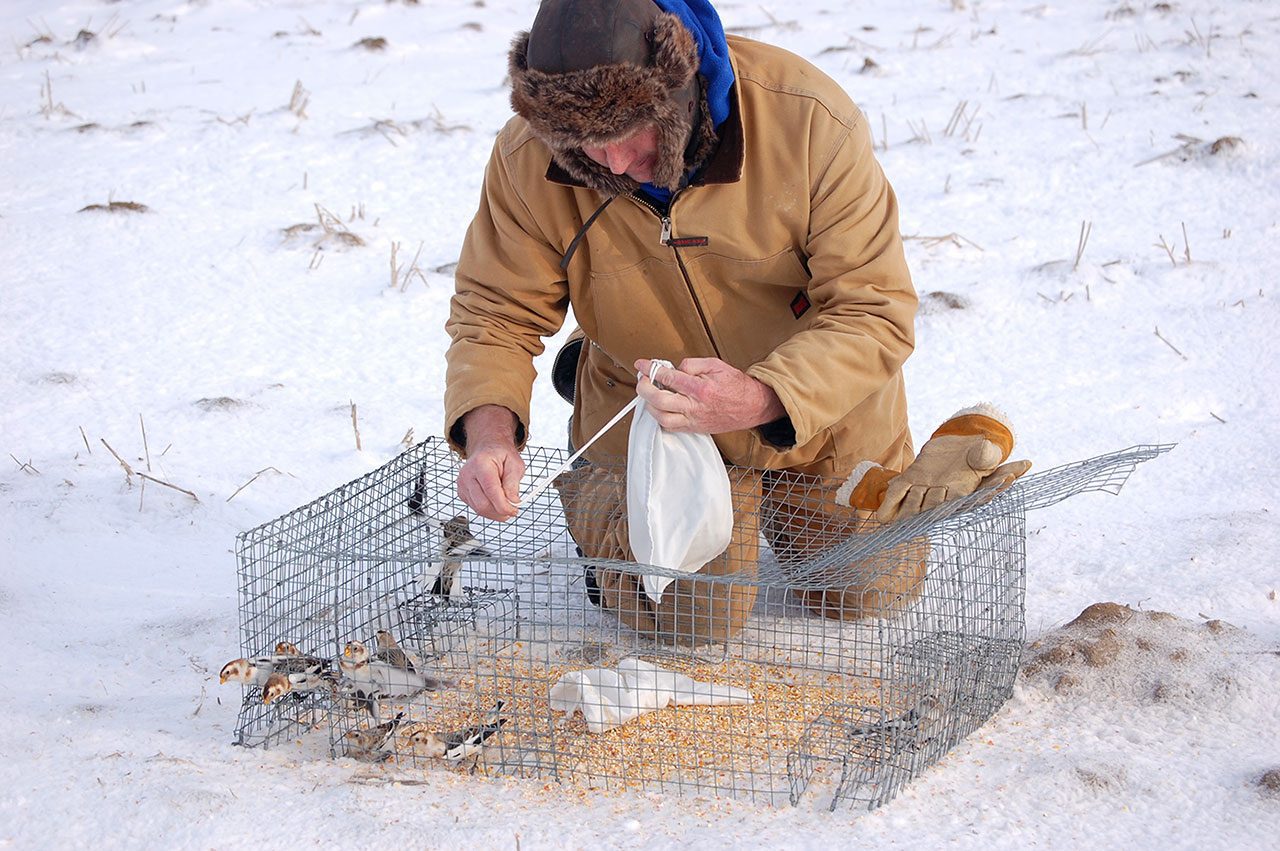
For decades, bird banders have trapped Snow Buntings in live traps made of wire mesh and baited with cracked corn. The birds typically walk right in and get caught, making them an easy species to work with. Until 2009, the Canadian Snow Bunting Network was an informal operation, sort of a ragtag community of bird banders primarily in Ontario, with each bander more or less keeping their own records. Some were scientists who kept meticulous notes about the birds’ ages, sexes, and body conditions, while others were in it for the fun of operating an outdoor wildlife project for schoolchildren. All were people who just loved these hardy little birds and wanted to work with them.
Love formalized the process by connecting this disparate network of enthusiasts and recruiting experienced banders into the project. Soon there was a formal protocol for banders to follow and an annual newsletter, The Snow Bunting Report, that summarized each year’s progress, distributed tips for identifying a bird’s age or sex, and shared new research that the network was helping to inform. Each of the dozen or so banding groups in the network was recording detailed measurements, along with age and sex information. Some were even pulling feathers for isotope analysis, a lab technique that can reveal where individual birds have come from. It wasn’t long before patterns began to emerge.
One of the first things Love and his research partners noticed was a correlation between local conditions and gender: the colder a given location, the more likely the flocks would be made up of males.

Male Snow Bunting in breeding plumage. Photo by Christoph Moning/Macaulay Library. 
Female Snow Bunting in breeding plumage. Photo by Christoph Moning/Macaulay Library. 
Male and female Snow Buntings in nonbreeding plumage can be hard to tell apart. Photo by Shimmeringenergy via Birdshare.
“In Winnipeg we hardly ever get females,” says Emily McKinnon, a postdoctoral researcher working with Love. “If you go to Windsor, right across from Detroit, you get mostly females.”
Winnipeg is about 600 miles north of Windsor. That same gender split held with other comparisons of northern and southern sites. McKinnon and Love eventually concluded that because male Snow Buntings are slightly bigger and slightly better able to tolerate cold, they can ride out winter weather farther north than females.
But the crux of their research focused on the Snow Bunting’s wide-ranging winter lifestyle. Recoveries from the banding network provide a trickle of information, but in recent years Love and his team have introduced sophisticated tracking tools—such as tiny geolocators, and nanotags that ping a bird’s location whenever it flies by a tower in the MOTUS monitoring network (see The New Migration Science, Spring 2017). The tracking data show that Snow Buntings wander a lot farther than scientists previously thought.
“I think the impression was that they roam around within a couple kilometers,” explains McKinnon. “I’m picking up birds at towers 200 kilometers [about 125 miles] across the province, and then 100 kilometers [about 60 miles] in the opposite direction the next day. It’s hard to imagine how they know where they’re going.”
But the evidence suggests that they do. Even though Snow Bunting flocks wander incredible distances, they consistently come back together at the same places, even if only for a day or two before lighting out again on another 100-kilometer jaunt. Flocks of Snow Buntings seem to be setting off on foraging expeditions all over the landscape, McKinnon says, during ephemeral windows when conditions—weather, snow cover, and food availability—are ideal. But they consistently appear to return to areas with abundant, reliable food resources, say a cornfield with a ready supply of leftover grain and a clear view of approaching predators.
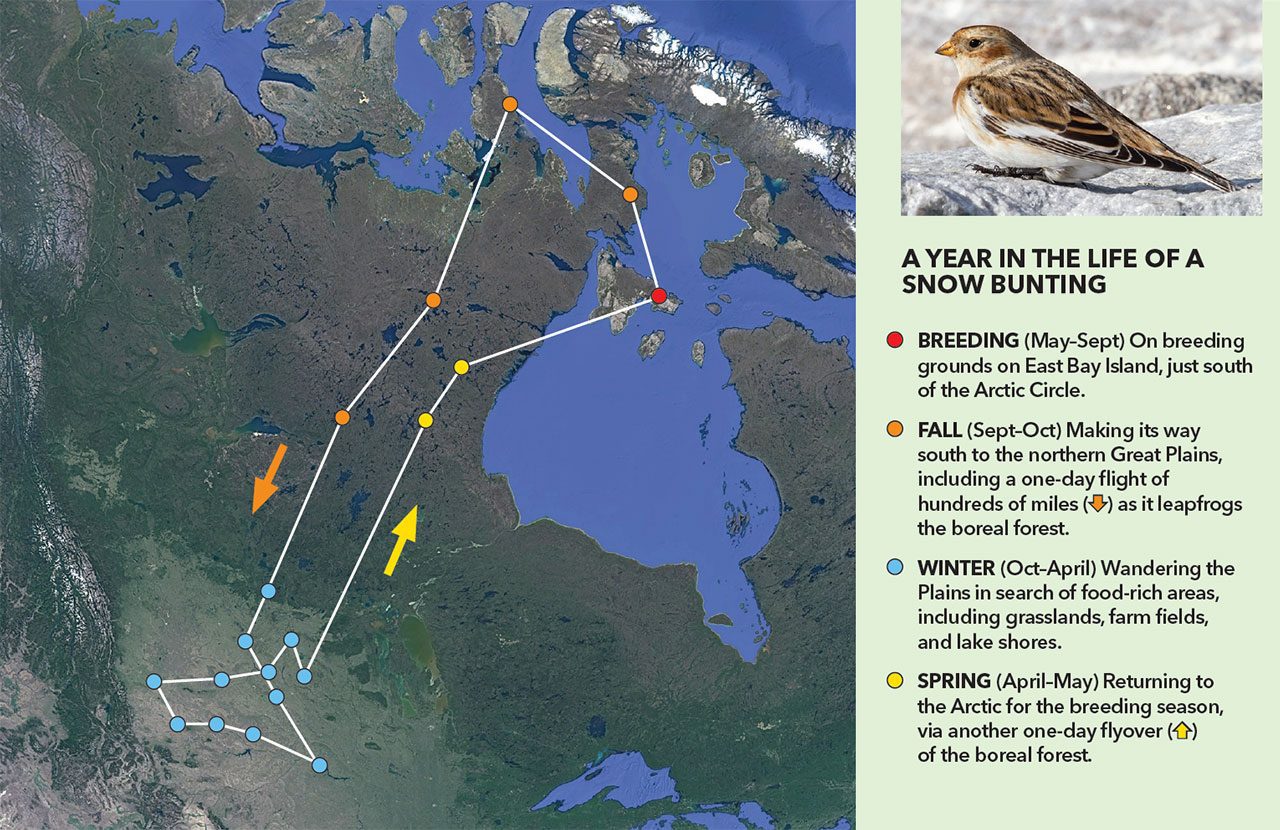
The Snow Bunting’s biggest forays are its migrations between tundra breeding grounds and wintering areas among the farm fields of Canada and the northern U.S., when it flies across the largest expanse of forest on the continent. The boreal forest is home sweet home for billions of forest birds, but it may as well be an ocean for open-country species such as Snow Buntings. In fact, Love and his team have found through geolocator tracking that migrating Snow Buntings actually treat the boreal forest like an ocean, much like Ruby-throated Hummingbirds treat the Gulf of Mexico—as an enormous barrier to cross over. The buntings bypass the entire forest in nonstop flights of hundreds of miles.
A decade after that report sounded alarm bells about a 64 percent Snow Bunting decline, Partners in Flight issued a new report in 2016 that pegged the decline at 38 percent since 1970—not as bad, but still pretty steep. Love still isn’t sure about the accuracy of these estimates, but whatever the exact number may be, he notes that Snow Bunting populations may be showing a lag from widespread forest clearing that happened a century ago. He says Snow Buntings might just now be coming down off a midcentury population boom as those clearings return to forest. Looking ahead, he says intensification of corn agriculture— creating even more vast fields of winter stubble—may actually benefit wintering Snow Buntings, even if it’s harmful to many forest and grassland birds.
Love says that today Snow Bunting populations appear to be declining in some Canadian provinces, but in others they may be flat or increasing. From a continent-wide perspective, the birds might just be flying between different provinces from year to year. It’s hard to tell for sure based only on wintertime counts, without the benefit of breeding bird surveys.
Still, Love says his research “has actually revealed more complexity than … one trend line for North America as a whole [can show].”
And this winter the Canadian Snow Bunting Network will continue to band more buntings and add more data, helping Love as he continues to try to assemble the big picture for a species that’s prone to scattering across remote snowy countrysides.
Nate Swick is social media manager for the American Birding Association and hosts the ABA’s American Birding podcast. He lives in Greensboro, North Carolina.

All About Birds
is a free resource
Available for everyone,
funded by donors like you
American Kestrel by Blair Dudeck / Macaulay Library
